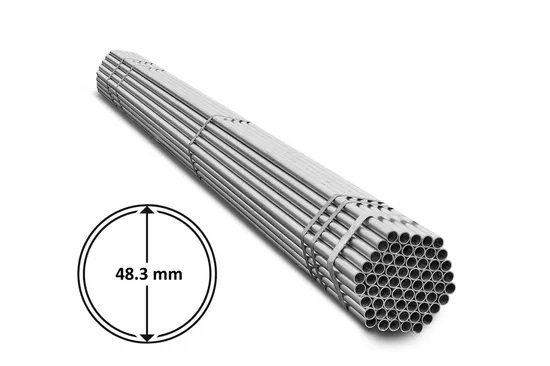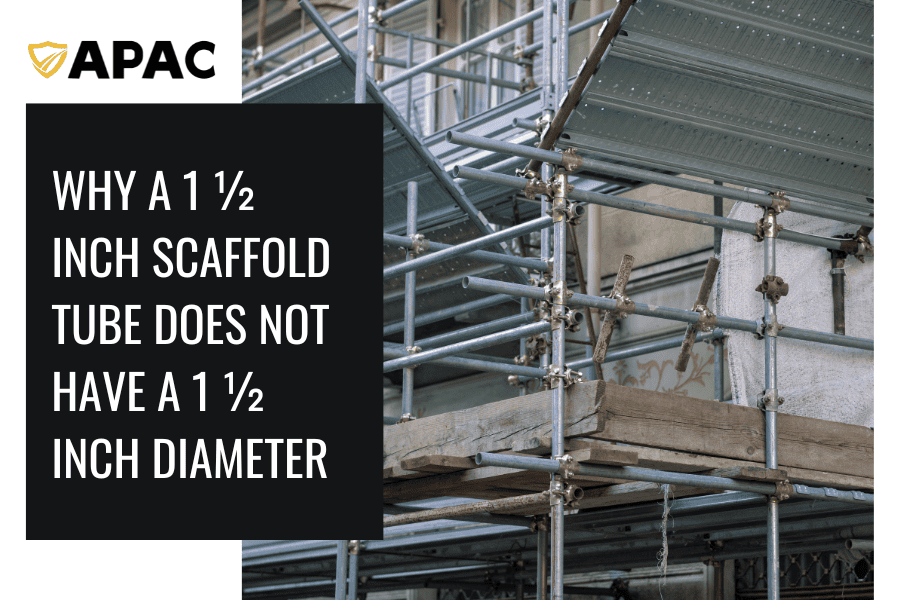Introduction
A 1 ½ inch scaffold tube is widely used in construction projects for safety and support. But, its actual diameter is not 1 ½ inches, which may confuse some people. This difference happens because of the way tubes are measured and the standards used in manufacturing.
The term “1 ½ inch” refers to a nominal size, not the real size of the tube. The real diameter of a scaffold tube is about 1.9 inches. Understanding this is important for using the right equipment.
The size mismatch is based on old measurement systems, yet the industry still uses them. Knowing why this difference exists helps ensure safe construction practices and prevents mistakes in selecting scaffold parts.

What Diameter Is a Scaffold Tube?
When you hear the term “1 ½ inch scaffold tube,” you might assume that the tube has an outside diameter of 1 ½ inches. However, this is not true. The real outside diameter of a standard scaffold tube is about 48.3 mm, which is roughly 1.9 inches. This standard size is used around the world, ensuring that all scaffold parts work together, no matter where they come from.
Understanding the actual size of scaffold tubes is important. Scaffold systems are made of various parts, and each part is designed to fit together in a specific way. If the parts don’t match, it can lead to unsafe conditions. For this reason, scaffold tubes have a precise size to ensure everything fits correctly.
The 1 ½ inch term used in scaffolding refers to the nominal size. This means it’s more of a name or label for the size, not the actual measurement of the tube.
The idea of using a nominal size comes from older measurement systems, where tubes were often measured by their internal diameter. Even though scaffolding tubes today have different uses and requirements, the old naming system is still used.
Scaffold tubes are generally made from steel or aluminum. Steel tubes are strong and can carry heavy loads, making them suitable for large construction projects. Aluminum tubes, on the other hand, are lighter but still strong enough for smaller projects. In both cases, the outside diameter stays the same to maintain compatibility with other scaffold parts.
The thickness of the tube’s walls is also important. For steel scaffold tubes, the wall thickness is usually about 4 mm. This thickness adds strength to the tube, allowing it to hold up under heavy weight.

How Scaffold Tubes Are Manufactured
The tubes need to be reliable and able to handle heavy loads, which is why their manufacturing process follows strict standards.
There are two main ways to make scaffold tubes: hot-rolling and cold-forming.
Hot-rolling
In this method, steel is heated to a very high temperature. Once it reaches the right heat, it is passed through rollers that shape the steel into a long, tubular form. Hot-rolling is effective because it helps the steel take on a uniform thickness and a smooth surface. This method is common in making strong tubes that can handle a lot of pressure.
Cold-forming
Cold-forming involves shaping the steel at room temperature, without heating it up. While this process takes more force, it gives the final tube more strength. The cold-forming process allows for more precise control over the tube’s dimensions, making it an excellent choice when accuracy is important. Cold-formed tubes are often stronger than hot-rolled ones, though both types are used in scaffolding depending on the project’s needs.
After the tubes are shaped, they are welded along the seam where the two edges of the metal meet. This welding is essential for making sure the tube stays strong and does not split or break. The welding process uses high heat to melt the edges of the metal and bond them together, ensuring that the tube can hold up to the weight it will need to support on a construction site.
Once the welding is complete, many scaffold tubes go through galvanization. This process involves coating the steel tube with a layer of zinc. The zinc protects the steel from rusting and corrosion, which is especially important since scaffold tubes are often used outdoors where they are exposed to the weather. Galvanized tubes last much longer than unprotected tubes and are more reliable in harsh environments.
After all these steps, the scaffold tubes are carefully inspected to make sure they meet strict quality standards. Standards like EN 39 for steel scaffold tubes ensure that the tubes are safe and reliable for construction work.
The tubes are tested for their thickness, diameter, and weld strength to make sure they can hold the weight and stress they will face on a construction site. Any tubes that fail these tests are rejected, ensuring that only the best tubes make it to the market.
Why a 1 ½ Inch Scaffold Tube Does Not Have a 1 ½ Inch Diameter
One of the most confusing things about scaffold tubes is that a 1 ½ inch tube does not actually measure 1 ½ inches across. The reason for this is rooted in old measurement systems and how tubes were named in the past.
In the early days of tube manufacturing, tubes were often used for plumbing. At that time, the internal diameter of the tube was more important than the outside diameter because the inside determined how much water could flow through the pipe. As a result, the tubes were named after their internal diameter, not their external size.
Even though scaffold tubes today have a different purpose and need different measurements, the old naming system stuck.
So, even though we still call them 1 ½ inch tubes, the actual outside diameter of a modern scaffold tube is about 1.9 inches. The term “1 ½ inch” has become more of a label or nominal size, rather than a true measurement. This nominal size has stayed the same for consistency, even though the tubes themselves have changed over time to meet the needs of construction work.
The increase in the actual diameter of scaffold tubes happened because of safety and strength requirements. As scaffolding became more common in construction, the tubes needed to be stronger to handle heavier loads. This led to thicker walls and larger outside diameters, even though the industry kept calling them 1 ½ inch tubes to avoid confusion with older systems.
For people who are not familiar with scaffolding, this size mismatch can be confusing. However, professionals in the construction industry understand that the nominal size is just a historical label, not an exact measurement. As long as they use the correct size tubes, they can build safe and stable scaffolding systems.

Why the Size Discrepancy Matters for Construction
The difference between the nominal size and the actual size of scaffold tubes is more than just a technical detail. It has real implications for safety and efficiency on construction sites.
Scaffold systems are designed with specific tube sizes in mind. Each part of the scaffolding – from the tubes to the clamps and joints – is made to fit together based on these standard sizes. If the tubes are not the correct size, they may not fit properly with other scaffold components. This can lead to dangerous situations where the scaffolding is unstable and could collapse, putting workers at risk.
Using the wrong size tube can also make it harder to build scaffolding quickly and efficiently. If parts don’t fit together as they should, it can slow down the construction process and make it more difficult to set up safe platforms for workers. Having the correct tube size ensures that all parts fit smoothly, allowing workers to assemble scaffolding systems quickly and safely.
The size discrepancy also matters when it comes to replacing parts. If a part of the scaffolding gets damaged and needs to be replaced, using a tube that is not the right size could create weak spots in the structure.
Even a small difference in size can affect the strength of the scaffolding, increasing the risk of accidents. This is why it is so important to stick to the standard sizes and avoid mixing parts that do not match.
Construction regulations are also based on the standard 48.3 mm diameter of scaffold tubes. These rules are in place to make sure that scaffolding systems are safe and can support the weight they need to carry. By following these regulations and using tubes with the correct size, construction workers can be sure that their scaffolding systems meet safety requirements.
Conclusion
A 1 ½ inch scaffold tube does not actually have a 1 ½ inch diameter because of old naming systems. The term “1 ½ inch” is a nominal size, not the real measurement. The real outside diameter of the tube is around 1.9 inches or 48.3 mm.
This difference comes from how tubes were measured in the past, where the internal diameter mattered more. Even though scaffold tubes are now used differently, the old naming continues.
Understanding this size difference is important for construction workers. Using the correct size ensures scaffolding parts fit together and meet safety standards. This helps prevent accidents and keeps the scaffolding strong and stable.











